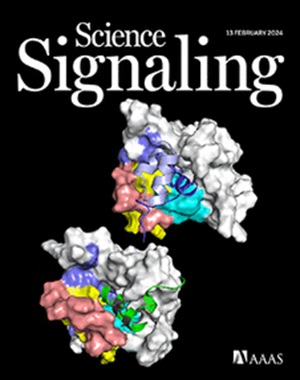白细胞介素15和18通过mTORC1的非典型激活协同启动自然杀伤细胞的抗肿瘤功能。
IF 6.6
1区 生物学
Q1 BIOCHEMISTRY & MOLECULAR BIOLOGY
引用次数: 0
摘要
多蛋白复合物mTORC1对于蛋白质合成和生物能量代谢的增加至关重要,这些代谢支持许多细胞类型的增殖,包括自然杀伤细胞(NK细胞),它们是抗肿瘤反应的重要先天效应物。在这里,我们研究了白细胞介素-15 (IL-15)和IL-18在NK细胞中激活mTORC1的机制,它们促进NK细胞的功能,并且是用于癌症免疫治疗中预激活NK细胞的细胞因子混合物的组成部分。通过遗传学和药理学方法,我们发现IL-15通过PI3K/Akt/ERK通路激活mTORC1,而IL-18通过p38效应物MK2和MK3在小鼠和人原代NK细胞中发出信号。这两种途径协同作用,以mtorc1依赖的方式促进NK细胞增殖和效应功能。此外,这两种途径独立于抑制剂TSC和激活剂Rheb,揭示了细胞因子激活mTORC1的非规范模式。IL-15和IL-18联合治疗小鼠导致NK细胞数量增加,抗肿瘤活性提高,表明这种细胞因子组合可以在治疗环境中增强NK细胞的潜力。本文章由计算机程序翻译,如有差异,请以英文原文为准。

Interleukins 15 and 18 synergistically prime the antitumor function of natural killer cells through noncanonical activation of mTORC1
The multiprotein complex mTORC1 is essential for the increase in protein synthesis and bioenergetic metabolism that supports the proliferation of many cell types, including natural killer (NK) cells, which are important innate effectors of the antitumoral response. Here, we investigated the mechanisms of mTORC1 activation in NK cells by interleukin-15 (IL-15) and IL-18, which promote NK cell function and are components of a cytokine cocktail used to preactivate NK cells for cancer immunotherapy. Through genetic and pharmacological approaches, we showed that IL-15 activated mTORC1 through the PI3K/Akt/ERK pathway, whereas IL-18 signaled through the p38 effectors MK2 and MK3 in both murine and human primary NK cells. Both pathways synergized to promote NK cell proliferation and effector functions in an mTORC1-dependent manner. Moreover, both pathways operated independently of the inhibitor TSC and the activator Rheb, revealing a noncanonical mode of mTORC1 activation by cytokines. Treating mice with IL-15 and IL-18 in combination led to increased NK cell numbers and improved antitumoral activity, suggesting that this cytokine combination could be exploited to enhance NK cell potential in therapeutic settings.
求助全文
通过发布文献求助,成功后即可免费获取论文全文。
去求助
来源期刊

Science Signaling
BIOCHEMISTRY & MOLECULAR BIOLOGY-CELL BIOLOGY
CiteScore
9.50
自引率
0.00%
发文量
148
审稿时长
3-8 weeks
期刊介绍:
"Science Signaling" is a reputable, peer-reviewed journal dedicated to the exploration of cell communication mechanisms, offering a comprehensive view of the intricate processes that govern cellular regulation. This journal, published weekly online by the American Association for the Advancement of Science (AAAS), is a go-to resource for the latest research in cell signaling and its various facets.
The journal's scope encompasses a broad range of topics, including the study of signaling networks, synthetic biology, systems biology, and the application of these findings in drug discovery. It also delves into the computational and modeling aspects of regulatory pathways, providing insights into how cells communicate and respond to their environment.
In addition to publishing full-length articles that report on groundbreaking research, "Science Signaling" also features reviews that synthesize current knowledge in the field, focus articles that highlight specific areas of interest, and editor-written highlights that draw attention to particularly significant studies. This mix of content ensures that the journal serves as a valuable resource for both researchers and professionals looking to stay abreast of the latest advancements in cell communication science.
 求助内容:
求助内容: 应助结果提醒方式:
应助结果提醒方式:


